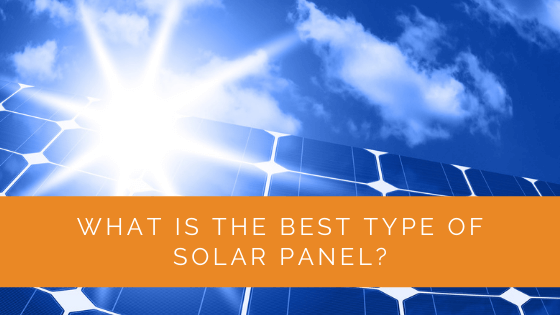Solar energy can substantially cut down on your carbon footprint, which is why you have decided to install solar panels. You may want to install them at home or use them in your RV, boat, or car, leaving you with a big question – what is the best solar panel type?
There are three common types of solar panels – monocrystalline, polycrystalline, and thin-film solar panels. So, what’s the best one? It depends upon multiple factors like your budget, power consumption, and other specific needs.
The different types of solar panels primarily differ according to the kind of solar cells used in them. This guide will tell you everything you need to know about choosing the best type of solar panel.
Contents
- 1 Key Takeaways
- 2 Types of Solar Panels
- 3 Thin Film Solar Panel Types
- 4 Types of Solar Panels by Efficiency
- 5 Types of Solar Panels by Cost
- 6 What Are the Common Solar Panel Types in the Market Today – By Appearance
- 7 Other Factors to Consider While Choosing Solar Panels
- 8 Solar Panel FAQ
- 9 Case Study: Choosing the Right Solar Panel Type for the Smith Family
- 10 Expert Insights From Our Solar Panel Installers About the Best Type of Solar Panel
- 10.1 Monocrystalline Solar Panels (Mono-Si)
- 10.2 Polycrystalline Solar Panels (Poly-Si)
- 10.3 Thin-Film Solar Panels (TFSP)
- 10.4 Cadmium Telluride (CdTe) Thin-Film Panels
- 10.5 Amorphous Silicon (a-Si) Thin-Film Panels
- 10.6 Copper Indium Gallium Selenide (CIGS) Thin-Film Panels
- 10.7 Bifacial Solar Panels
- 10.8 PERC Panels
- 11 Experience Solar Excellence with Us!
- 12 Wrap Up
Key Takeaways
- The best type of solar panel depends on factors like your budget, power consumption, and specific needs.
- Monocrystalline solar panels are the most efficient but costlier due to their manufacturing process.
- Thin-film solar panels are the cheapest but less efficient, making them suitable for specific applications and budget-conscious consumers.
Types of Solar Panels
Choosing the right solar panel can be a game-changer in harnessing solar energy efficiently. Our article dives into solar panels, shedding light on three main types: Monocrystalline, Polycrystalline, and Thin-Film Solar Panels. Each type brings unique features and efficiencies to the table. Here is an in-depth comparison of these solar panel types, focusing on key aspects such as manufacturing processes, efficiency rates, cost considerations, and suitability for different applications. Whether you’re a homeowner looking to reduce your carbon footprint or a business exploring sustainable energy options, understanding these solar panel types is essential for making an informed decision.
Monocrystalline Solar Panels (Mono-Si)
Monocrystalline solar panels are among the most common types of solar panels today. That is because it is the most efficient of the three.
Its name mono-si comes from its manufacturing process where monocrystalline solar cells are made using the Czochralski method. It includes melting one seed crystal of silicon under high temperatures to create one silicon crystal. This crystal is further sliced into multiple wafers making way for solar cells.
You can easily identify monocrystalline solar cells with their black color due to the use of one silicon. While this process makes them highly efficient, it also makes these solar cells costliest of all. That is because this manufacturing process leads to wasting a sizeable amount of silicon.
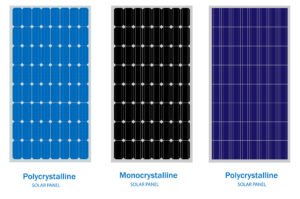
Polycrystalline Solar Panels (Poly-Si)
The prime differentiating factor between monocrystalline and polycrystalline panels is the manufacturing process.
Polycrystalline solar cells are made from different silicon crystals. For this, the fragments are first melted at high temperatures and poured into square molds, leading to polycrystalline cells. Therefore, these cells are relatively more affordable as silicon is not wasted during the manufacturing process.
At the same time, the use of different silicon fragments makes polycrystalline panels comparatively less efficient than monocrystalline ones. Additionally, they have a lower tolerance to high temperatures and other extreme weather conditions.
Thin-Film Solar Panels (TFSP)
Thin-film panels get their name from the way they are formed. Solar panel manufacturers roll out different layers of semiconductors like cadmium telluride, amorphous, and copper indium gallium selenide (CIGS) on a surface. These layers are so thin that the final product comes out to be relatively flexible. Besides, a thin film panel does not require a metal frame, making it all the lighter.
Another factor that differentiates thin-film panels from monocrystalline and polycrystalline panels is their size. While the latter two come in fixed cell counts like 60, 72, or 96, the size of one thin-film panel can be anything you need. However, thin-film cells are not as efficient as polycrystalline and monocrystalline panels.
As a result of its production process, thin-film panels are the cheapest among all the options. These are incredibly light, requiring minimal labor for installation. Therefore, the overall cost of their manufacturing and installation process is relatively less.
Thin Film Solar Panel Types
Unlike pure crystalline silicon panels, thin-film solar panels use different materials and thus vary in characteristics.
Cadmium Telluride (CdTe)
These thin-film solar panels use Cadmium Telluride as the photovoltaic material to produce solar cells. With this solar panel technology, the manufacturing process becomes low-cost as it requires the least amount of water. Besides, their energy payback time is only one year.
That being said, cadmium solar production is still not the most sought-after solar technology due to its toxic nature. To minimize its negative impact on the environment, the recycling process of this panel is the most tedious and the most expensive of all.
Amorphous Silicon (a-Si)
Amorphous Silicon or a-si panels are only about 1 micrometer in thickness. Unlike crystalline silicon cells, these thin-film panels comprise solar cells made from three layers of semiconductors. Such a construction results in a lower efficiency rating of 7% as against 18% rating of a single silicon crystal cell.
Apart from this downside, amorphous silicon panels have the upside of being relatively pocket-friendly. Moreover, a solar panel manufacturer can easily use them for small devices like pocket calculators due to their delicate nature.
Copper Indium Gallium Selenide (CIGS)
The CIGS panels are thin-film panels made from a thin layer each of copper, indium, gallium, and selenide. A manufacturer will deposit these materials on a plastic or glass backing.
As a result of this combination, the CIGS solar panel efficiency is the highest among thin-film panels. However, it is still not as good panels with pure silicon wafers.
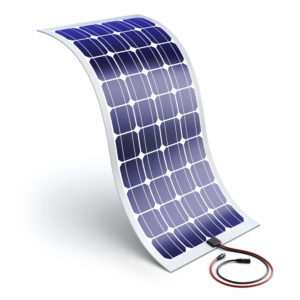
Types of Solar Panels by Efficiency
Monocrystalline Solar Panels
Monocrystalline panels are undoubtedly the best solar panels when it comes to performance. Their efficiency rating ranges from 17%-22%, making them the ideal choice for areas with limited space. For example, houses with limited roof space can easily use monocrystalline solar panels. They are made from pure silicon wafers, allowing the easy flow of electrons and increasing overall efficiency.
Besides, most monocrystalline panels also have the highest power capacity. For example, if a solar panel has a power capacity of 300-320 watts, it will reach up to 350-375 watts.
Polycrystalline Solar Panels
The efficiency rating of polycrystalline solar panels ranges from 15%-17%. It is visibly lower than monocrystalline panels due to the multiple silicon cells present. As a result, the electrons cannot move freely, leading to lower efficiency.
Polycrystalline solar panels also have a low power capacity as compared to monocrystalline panels. The output of these panels usually ranges from 240-300 watts.
Thin-Film Solar Panels
The efficiency of thin-film panels is visibly lower than crystalline solar panels. Ratings of CIGS panels range from 13-15%, CdTe panels from 9-11%, a-si from 6-8%.
Besides, you will need more thin-film solar panels than crystalline panels for the same amount of power. Therefore, these are not the best solar panels for residential installations. Moreover, you will have to pay extra fees to the solar installer for the solar installation process.
Types of Solar Panels by Cost
Monocrystalline Solar Panels
Though they perform the most efficiently, these types of solar panels are also the most expensive. That is because each solar cell of these panels is made from pure silicon, resulting in 50% of the silicon getting wasted. However, with solar power system technology improvements, the price gap between monocrystalline and polycrystalline solar panels has dramatically reduced.
Polycrystalline Solar Panels
Polycrystalline panels are mid-ranged solar panels along with considerable efficiency and overall performance. Therefore, most households adopt a polycrystalline solar panel system.
That said, the efficiency rating of polycrystalline modules is still lower than monocrystalline panels. Therefore, you must consider both factors while making the final choice.
Thin-Film Solar Panels
A thin-film solar system is the cheapest option in the market. Among these solar panels, CIGS is the costliest, followed by CdTe and amorphous silicon. Additionally, these are the easiest to install.
Despite their low prices, thin-film solar panels are not always the best due to their overall performance. Moreover, their quality deteriorates fast, leading to the need for quick replacements.
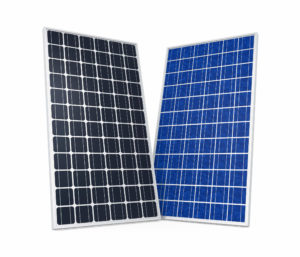
What Are the Common Solar Panel Types in the Market Today – By Appearance
While thin-film solar panels are the best-looking ones, the solar industry is witnessing constant innovation. These panels are flexible enough to fit on any surface. However, you will need a lot of these solar panels to meet your power needs.
Monocrystalline solar panels make for the second-most attractive solar panels in the market today, followed by polycrystalline panels. The former has a solid black color while polycrystalline cells display a blue, marble-like look. As a result, most homeowners do not prefer a polycrystalline panel as it lacks an aesthetic appeal.
Solar Shingles
Solar shingles are the most common and trendiest solar panels nowadays. These either include monocrystalline or polycrystalline solar cells, producing around 13-67 watts of power. Still, what makes them stand out is their beautiful architectural look.
A manufacturer can design shingles of varying designs. For example, you can easily find solar shingles mimicking the asphalt shingle roof. Besides, they are efficient and can withstand extreme weather conditions. However, these types of solar panels are costlier than the standard ones.
Bifacial Solar Panels
Bifacial solar panels comprise solar cells that can produce energy from both sides. Unlike traditional panels, these do not have a backsheet, leading to higher efficiency and solar energy production.
As a result, commercial buildings are essentially adopting this type of solar panel. Moreover, a bifacial solar panel is cheaper than a mono-facial one over the long run. You can also use them for home as they can prove to be more efficient despite limited space.
PERC Panels
Another solar industry innovation, the Passivated Emitter and Rear Cell solar panel, is pretty efficient. This new type of solar panel is an improvised version of the traditional monocrystalline solar panel. It comes with an added layer at the back that helps collect more sunlight and produce a higher amount of solar energy. Therefore, a PERC cell proves to be better than a traditional solar cell.
When it comes to appearance, this solar panel looks similar to solid black-colored polycrystalline panels.
Other Factors to Consider While Choosing Solar Panels
Temperature Coefficient
Though thin-film panels do not rank high in other categories, they have the best temperature coefficient. But what does it mean? As the temperature increases, solar panels produce electricity at a lower rate. The temperature coefficient is a measure of reduction in electricity generated for every 1°C over 25°C.
At a standard rate, polycrystalline and monocrystalline solar panels tend to generate electricity at the rate of -0.3%/°C to -0.5%/°C. However, thin-film panels produce electricity at the rate of -0.2%/°C, thus, handling high temperatures with ease.
Mounting Style
Would you prefer solar shingles or a solar system with flat panels? If you wish to take your aesthetics a notch higher, you can opt for solar shingles. However, remember that you would need them in large numbers.
Apart from these, you may also opt for crystalline panels with trackers. This addition will allow you to place them in your yard or flat roof and move them around according to the sun’s direction.
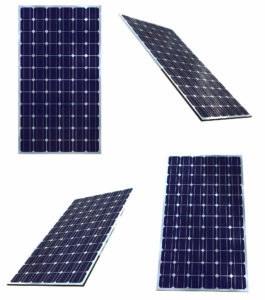
Resistance to Hail and Fire
Another point to consider while selecting the best type of solar panel is its resistance level. According to your roof style and the type of panel, consider the fire rating of the panel.
Besides, you must also check the panel’s resistance to hail. Monocrystalline and polycrystalline panels can withstand up to 25 mm of hail falling at the rate of 50 mph.
Solar Panel FAQ
Which is better? Monocrystalline or polycrystalline solar panel?
When it comes to monocrystalline vs. polycrystalline panels, there are no right solar panels for everyone. It depends on your requirements and budget.
Monocrystalline panels are relatively more efficient, have a better power capacity, and overall better performance. However, they are comparatively more expensive. Therefore, if you have the budget, choosing monocrystalline panels is the better option.
On the other hand, if you’re looking for a pocket-friendly option, pick one of the different styles of polycrystalline panels.
What is the highest efficiency solar panel?
Monocrystalline panels are clearly the most efficient panels. Their efficiency ratings range from 17% to 22%, which is higher than both thin-film and polycrystalline solar panels.
Do solar panels require maintenance?
Yes, irrespective of the solar panel type, these devices require routine maintenance. However, it is pretty minimal. Make sure the panels remain free of dust, leaves, and other debris to ensure maximum sunlight reaches the panels. Apart from this, solar panels require additional care during times of heavy snowfall.
Are solar panels worth it?
Yes, if you choose quality solar panels, they are absolutely worth it as they’ll last for up to 20 years. Installing a solar power system substantially reduces your carbon footprint and saves money in the long run. With this, you can cut down on electricity bills and enjoy free electricity for years to come.
Case Study: Choosing the Right Solar Panel Type for the Smith Family
Finding the Perfect Solar Panel: The Smith Family’s Journey
Background
The Smith family in Tucson, Arizona, aimed to reduce their electricity bills and carbon footprint by installing solar panels. They consulted Solar Panels Network USA to choose the best type of solar panel.
Objective
To determine the most suitable solar panel type by considering budget, energy consumption, and aesthetic preferences.
Analysis and Decision
Monocrystalline Solar Panels:
- Pros: High efficiency (17%-22%), long lifespan, and sleek black appearance.
- Cons: Higher cost.
Polycrystalline Solar Panels:
- Pros: Cost-effective, good efficiency (15%-17%).
- Cons: Less efficient, blue-speckled look.
Thin-Film Solar Panels:
- Pros: Flexible, lightweight, lowest cost.
- Cons: Lower efficiency (6%-15%), shorter lifespan.
Choice and Results
The Smiths chose monocrystalline panels for their high efficiency and aesthetics. Solar Panels Network USA installed a 6kW system, which was completed in three days.
Outcomes:
- Energy Efficiency: Reduced electricity bills by 80%.
- Aesthetic Satisfaction: Sleek panels enhanced curb appeal.
- Maintenance: Minimal upkeep required.
Summary
The Smith family’s experience shows the importance of evaluating solar panel options based on specific needs. By choosing monocrystalline panels, they achieved efficiency, aesthetics, and long-term savings. This case study emphasizes the value of expert consultation for tailored solar energy solutions.
Expert Insights From Our Solar Panel Installers About the Best Type of Solar Panel
Monocrystalline Solar Panels (Mono-Si)
As experienced solar installers, we often recommend monocrystalline panels for clients looking for maximum efficiency and longevity. These panels offer the highest efficiency rates, typically ranging from 17% to 22%, making them ideal for homeowners with limited roof space. Despite their higher cost, the investment pays off in terms of energy output and durability. We’ve seen countless installations where these panels have performed exceptionally well, even in less-than-ideal weather conditions.
Polycrystalline Solar Panels (Poly-Si)
Polycrystalline panels are a popular choice among budget-conscious customers. While they are less efficient than monocrystalline panels, their performance is still robust enough for many residential applications. In our installations, we’ve found polycrystalline panels to be reliable and cost-effective, particularly in areas with ample sunlight. They strike a good balance between efficiency and affordability, making them a practical choice for many households.
Thin-Film Solar Panels (TFSP)
Thin-film panels are incredibly versatile due to their lightweight and flexible nature. We often recommend these for unique applications like RVs, boats, and other non-traditional settings. However, it’s important to note that their efficiency is lower than both monocrystalline and polycrystalline panels. Despite this, their ease of installation and lower cost can make them an attractive option for specific use cases. In our experience, these panels are best suited for projects where space and weight are significant considerations.
Cadmium Telluride (CdTe) Thin-Film Panels
CdTe panels are an interesting option due to their lower production costs and reduced water usage during manufacturing. However, their toxic nature requires careful handling and recycling, which can increase the overall cost and complexity. We’ve installed these panels in select commercial projects where their specific benefits outweigh the downsides, but they are less common for residential use due to these concerns.
Amorphous Silicon (a-Si) Thin-Film Panels
Amorphous silicon panels are known for their low cost and thin profile, which makes them suitable for small devices and applications where traditional panels might be too bulky. Although their efficiency is lower, around 7%, their affordability and ease of integration into various products make them a viable option for specific needs. We’ve seen these used effectively in portable solar devices and smaller installations.
Copper Indium Gallium Selenide (CIGS) Thin-Film Panels
CIGS panels offer the highest efficiency among thin-film options, making them a good choice when higher performance is needed from a thin-film panel. While still not as efficient as crystalline panels, their flexibility and relatively high efficiency make them suitable for a variety of applications. We’ve installed CIGS panels in both residential and commercial projects where their unique properties provide distinct advantages.
Bifacial Solar Panels
Bifacial solar panels are a great innovation, allowing energy production from both sides of the panel. This increases their efficiency and overall energy yield, especially in reflective environments like snowy or sandy areas. We’ve successfully integrated bifacial panels into commercial projects, and they have shown excellent performance and reliability.
PERC Panels
PERC (Passivated Emitter and Rear Cell) panels represent a significant advancement in solar technology. By adding a layer to capture more sunlight, they improve efficiency and power output. In our installations, PERC panels have consistently outperformed standard monocrystalline panels, particularly in areas with high temperatures. They are an excellent choice for those looking to maximize their solar energy production.
Choosing the right type of solar panel depends on your specific needs, budget, and installation environment. Our experienced team is always ready to provide personalized recommendations to help you make the best decision for your solar energy project.
Experience Solar Excellence with Us!
Trust in Solar Panels Network USA, where our seasoned experts deliver top-quality solar solutions for homes and businesses nationwide. With a legacy of countless successful installations and a commitment to sustainable energy, we’re your reliable partner in the solar journey. Ready for a brighter, eco-friendly future? Call us now at (855) 427-0058 and harness the power of the sun!
Wrap Up
So, what is the best solar panel type? Well, there’s no one-size-fits-all.
If you measure it in terms of performance and efficiency, monocrystalline solar panels are the clear winners. Plus, you can install them even in a limited space. However, they are not the best options if you have a restricted budget. In such a case, polycrystalline and thin-film panels are better options.
Before selecting a solar panel, consider factors like budget, roof type, and the preferable location of the solar power system. The choice will also affect the maintenance requirements of the solar panels. For example, if you have a sliding roof, rainwater will remove most of the debris from the panels.
So, what’s the hold? Cross-check all the factors and pick the best type of solar panel now!
About the Author
Solar Panels Network USA stands at the forefront of solar energy solutions, driven by a team of seasoned solar engineers and energy consultants. With over decades of experience in delivering high-quality solar installations and maintenance, we are committed to promoting sustainable energy through customer-centric, tailored solutions. Our articles reflect this commitment, crafted collaboratively by experts to provide accurate, up-to-date insights into solar technology, ensuring our readers are well-informed and empowered in their solar energy decisions.

